B.R. Bates's Blog: From the social feeds ..., page 3
July 25, 2025
#RememberThem: Juanita
Born in June 1968, Juanita Hardy grew up in Detroit and went to Mumford High School on the west side in the 1980s. She was adopted as a youngster, but both of her adoptive parents passed away when she was still a kid. She had a guardian, maybe you could call her a foster mom, named Carrie. She also had a brother named Grant.
She was sometimes known as Joann Denise Hardy – at least that’s how her fingerprints ID’d her. So perhaps that was her name on the street. Juanita was her real name. Only a little more info can be culled together from the case files about Juanita, as attempts to contact people who knew her came up empty. At the time of this case, Juanita lived on Collingwood Street in Detroit, west of Woodward and east of the John C. Lodge Freeway. She reportedly had a crack problem. Carrie said she last saw Juanita in fall 1991; she was killed likely a month or two later.
Juanita was one of three women found on the same day at the Monterey Motel in Highland Park, Michigan, in February 1992. We honor her today as part of this #RememberThem series.
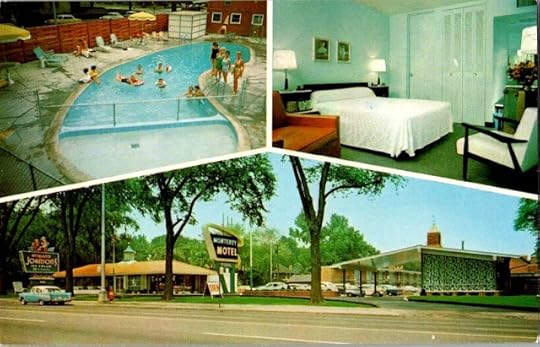 A postcard of the Monterey Motel from its heyday several decades ago. Photo from eBay.
A postcard of the Monterey Motel from its heyday several decades ago. Photo from eBay.
 A still from the crime-scene video of the Monterey Motel discovery that day. Juanita was discovered in this trash-strewn room,, while two other women were discovered in two other rooms, in February 1992.
A still from the crime-scene video of the Monterey Motel discovery that day. Juanita was discovered in this trash-strewn room,, while two other women were discovered in two other rooms, in February 1992. The police sketch of Room 35 of the motel where Juanita was found.
The police sketch of Room 35 of the motel where Juanita was found.This post is part of a series on this blog that I am calling #RememberThem, a chance to honor the women who encountered the two Detroit serial killers I have researched, John Eric Armstrong and Benjamin ("Tony") Atkins. In this continuing series, with installments dropping every week or so, we first learn more about the women Armstrong was known to have killed in Detroit, plus two of his survivors, then we turn to the women who encountered Atkins. Click on the "Honoring the Victims" label on the left to see all of the parts in the series. Also see the #RememberThem series on YouTube.. . . . . . . . . . . . . . . . . . . . . . . . . .
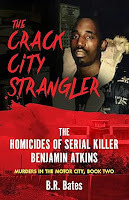
Postcard photo from eBay; other two images copyrighted and specifically for use in The Crack City Strangler: The Homicides of Serial Killer Benjamin Atkins; any other use prohibited without permission.
BRBates.com
wbp.bz/CrackCityStrangler
Murders in the Motor City Series
July 22, 2025
Mark your calendar for September 24 in Howard City ...
... because I'd love to meet you in person, and I'm sure my collaborator Dr. Gerald Cliff would, too! We'll be at the library in Howard City, Michigan, to talk about "The 'Baby Doll' Serial Killer: The John Eric Armstrong Homicides." You can get a signed copy of the book, ask us questions, and I'll be bringing along "The Crack City Strangler," too. Hope to see you there!
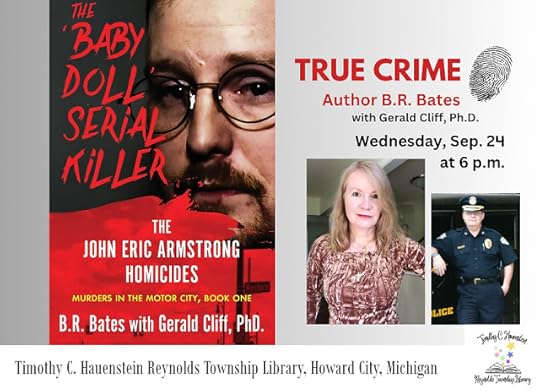
More deets >>>
July 18, 2025
#RememberThem: Bertha
The saddest part of Bertha's story is how her partner, William, saw her footprints trailing off in the snow outside their home on the night she disappeared. That's how he told it to police.
Bertha and William had four small kids – three boys and a girl who were age 1 to 4 at the time of this story.. When Bertha was out, William would stay at their house on Josephine Street in Detroit with their kids.
The last time William saw Bertha was at home on Saturday, December 14, 1991, around 6 p.m. He was upstairs and she had been downstairs. The kids came upstairs crying, telling him that their mom was gone again. William went downstairs, checked the front door, which was locked. He checked the side door, and it was cracked. When he looked out the door, he saw her footprints leading out the driveway in the snow.
He tried to follow the tracks for a while before they faded. They went toward Holbrook Avenue, which was one block south, on the east side of Detroit's historic Woodward Ave.
Sometime later, Bertha encountered Benjamin Atkins. Her body was discovered on December 30. Of all the family members of the women who were assaulted by this fast-moving serial killer, William was the one who had the most accurate recall of what Bertha was wearing the night she disappeared: Jogging pants and a white shirt with multicolored stripes, along with white “British Nikes.” She owned a black coat that she would also be wearing that night, and that coat would become evidence in the case.
We remember Bertha in this installment of the #RememberThem series.
 Bertha was found at 12 Alger in Detroit, a three-story, brick, commercial building behind a check-cashing place on Woodward Ave. This is Detroit Police's sketch of the scene.
Bertha was found at 12 Alger in Detroit, a three-story, brick, commercial building behind a check-cashing place on Woodward Ave. This is Detroit Police's sketch of the scene.This post is part of a series on this blog that I am calling #RememberThem, a chance to honor the women who encountered the two Detroit serial killers I have researched, John Eric Armstrong and Benjamin ("Tony") Atkins. In this continuing series, with installments dropping every week or so, we first learn more about the women Armstrong was known to have killed in Detroit, plus two of his survivors, then we turn to the women who encountered Atkins. Click on the "Honoring the Victims" label on the left to see all of the parts in the series. Also see the #RememberThem series on YouTube.
. . . . . . . . . . . . . . . . . . . . . . . . . .

Above photo is a copyrighted image of a case file and specifically for use in The Crack City Strangler: The Homicides of Serial Killer Benjamin Atkins; any other use prohibited without permission.
BRBates.com
wbp.bz/CrackCityStrangler
Murders in the Motor City Series
July 15, 2025
Thanks to Ron Chepesiuk for the fresh interview on "Crime Beat"
Ron Chepesiuk is a seasoned author and radio host who hosted me on his "Crime Beat" show a few months ago to talk about "The 'Baby Doll' Serial Killer" book and the case of John Eric Armstrong. I was honored to be a guest on his live show, once again, last Thursday night, this time to talk about the second book in the Murders in the Motor City series from WildBlue Press, "The Crack City Strangler," about the case of Benjamin Atkins. Ron's show airs on the ArtistFirst Radio Network.

In the episode, which you can now listen to online, we talk about the different aspects of the Atkins case, his troubled upbringing, his questioning by police and psychological profiling, as well as where that crazy term came from "the Crack City Strangler" -- because Detroit is not Crack City to this author, but it was a nickname that came from a media outlet (a newspaper in Canada) at the time of the case.
Thanks again, Ron!
July 11, 2025
#RememberThem: Debbie
Steak, macaroni and cheese, and vegetables.
That was reportedly the last meal Debbie cooked for her aunt before she disappeared. At least, that's what one of Detroit's daily newspapers reported at the time of this case. Steak, macaroni and cheese, and vegetables. Such a normal meal. For a normal life? It may have seemed normal in a lot of ways, but it was about to become a news headline, unfortunately, for Debbie.
Debbie was born in December 1960 to Charles Friday and Sadie Williams. She had three children. Not much else is known about her, and no one could be reached to speak for her in the book "The Crack City Strangler." A few tidbits can be scraped together from the case files: Back in 1985 or ‘86, Debbie was thrown out of a third-story window over some drug deal, her Uncle Herb recalled. Her mother last saw her on December 4, 1991. Herb last saw her a few days later, on the afternoon of the seventh, when he picked her up and drove her somewhere, then gave her a ride back again “while it was still light,” he later told police. Debbie would sometimes stay at a crack house for a few days. Then, an aunt last saw her on December 8, when Debbie cooked her dinner before departing the west-side house.

. . . . . . . . . . . . . . . . . . . . . . . . . .

Above photo is a copyrighted image of a case file and specifically for use in The Crack City Strangler: The Homicides of Serial Killer Benjamin Atkins; any other use prohibited without permission.
BRBates.com
wbp.bz/CrackCityStrangler
Murders in the Motor City Series
July 8, 2025
Four Victims, One Monster: Leslie Allen Williams
Multiple serial killers at work in the Motor City at the same time? When Benjamin ("Tony") Atkins was roaming Detroit's historic Woodward Ave in 1991 and 1992, Leslie Allen Williams was killing young girls in the northwest suburbs. And that's not all -- investigators also had tackled at least one other serial around that same time, operating in the western suburb of Inkster. What gives? Catch our thoughts on that and other aspects of the Williams case in this episode of @santanatruecrime that *just* dropped -- I'm listening right now!
🔗https://youtu.be/dLfZGECVJNk
https://www.youtube.com/@SantanaTrueCrime
Thanks, Cameron!
#SantanaTrueCrime #BRBates #TrueCrimeCommunity
#TrueCrimePodcast #SerialKillerStory #AuthorInterview #Crime
July 3, 2025
#RememberThem: Vickie
Six months before she was killed, Vickie Ann T. was crouching her tiny, 5-foot-1, 110-pound frame inside the kitchen closet of a basement apartment on Detroit’s east side, hiding with the door barely cracked as she watched her friend Reggie get shot and killed on the couch by a couple drug thugs looking for their money.
Vickie was no stranger to violence, and she was also no stranger to police. She had some arrests on her record, and she also told police in April 1991 about a man who held her against her will -- she escaped by climbing out of a second-story window. Just months later, she was killed by Benjamin Atkins. It was the end of a troubled life, and it's the case for a lot of these women, living at risk on the streets, that they so often encounter violence. And they feel they have no other options. They feel they have no value. That's at the heart of all of this.
Vickie is the victim of Benjamin Atkins that we honor in this installment of the #RememberThem series.
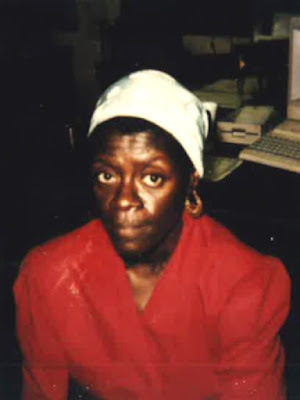
This post is part of a series on this blog that I am calling #RememberThem, a chance to honor the women who encountered the two Detroit serial killers I have researched, John Eric Armstrong and Benjamin ("Tony") Atkins. In this continuing series, with installments dropping every week or so, we first learn more about the women Armstrong was known to have killed in Detroit, plus two of his survivors, then we turn to the women who encountered Atkins. Click on the "Honoring the Victims" label on the left to see all of the parts in the series.
. . . . . . . . . . . . . . . . . . . . . . . . . .

Above photo obtained by FOIA to Detroit Police and specifically for use in The Crack City Strangler: The Homicides of Serial Killer Benjamin Atkins; any other use prohibited without permission.
BRBates.com
wbp.bz/CrackCityStrangler
Murders in the Motor City Series
July 1, 2025
Congrats to Cameron Santana for his new YouTube channel
Cameron Santana of the Santana Brothers, who are authors of their own true-crime book, has been interviewing true-crime authors and more for his podcast, launched a few months back. Now that podcast has moved into the YouTube sphere, which is just delightful. Check it out, like and subscribe! I was honored to be his very first podcast guest, and the video of that interview on convicted serial killer John Eric Armstrong and "The 'Baby Doll' Serial Killer" book is now up on their channel:
Congrats to the Santana Brothers for their new YouTube channel
The Santana Brothers, authors of their own true-crime book, have been interviewing true-crime authors and more for their podcast, launched a few months back. Now that podcast has moved into the YouTube sphere, which is just delightful. Check it out, like and subscribe! I was honored to be their very first podcast guest, and the video of that interview on convicted serial killer John Eric Armstrong and "The 'Baby Doll' Serial Killer" book is now up on their channel:
June 27, 2025
#RememberThem: Valerie
Valerie was born in December 1956 to Buster and Jessie Brown. The family lived on Ford Street in Highland Park. Valerie attended church and sang in the church choir (she had a beautiful voice, her son Andre told me). She was the baby of the family, the youngest of five kids. Everybody knew her in this tightknit community. And though André didn’t often get to see the “real” Valerie, the person his mom was at her core, unaltered by substances, he knows from glimpses here and there, and from what her family members have said, that she was a very sweet person. A big-hearted person. A funny person. A fairly naïve and innocent person, too, as the youngest in her family.
Valerie was a valuable human being who did not deserve to encounter a serial killer, to be left amid the rubble of a room at an abandoned motel off Woodward Avenue in Detroit.
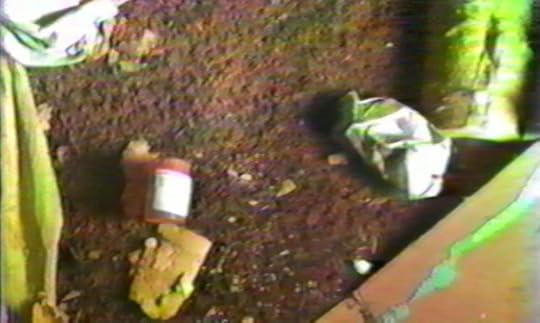 A still from the crime-scene video: the floor of Room 68 of the Monterey Motel on the day Valerie and two other women were discovered.
A still from the crime-scene video: the floor of Room 68 of the Monterey Motel on the day Valerie and two other women were discovered. A modern shot of the site on Woodward Avenue in Highland Park, Michigan, where the Monterey Motel once stood.
A modern shot of the site on Woodward Avenue in Highland Park, Michigan, where the Monterey Motel once stood. Police sketch of Room 58.
Police sketch of Room 58.This post is part of a series on this blog that I am calling #RememberThem, a chance to honor the women who encountered the two Detroit serial killers I have researched, John Eric Armstrong and Benjamin ("Tony") Atkins. In this continuing series, with installments dropping every week or so, we first learn more about the women Armstrong was known to have killed in Detroit, plus two of his survivors, then we turn to the women who encountered Atkins. Click on the "Honoring the Victims" label on the left to see all of the parts in the series.
. . . . . . . . . . . . . . . . . . . . . . . . . .

Above images are copyrighted and specifically for use in The Crack City Strangler: The Homicides of Serial Killer Benjamin Atkins; any other use prohibited without permission.
BRBates.com
wbp.bz/CrackCityStrangler
Murders in the Motor City Series
From the social feeds ...
- B.R. Bates's profile
- 8 followers



